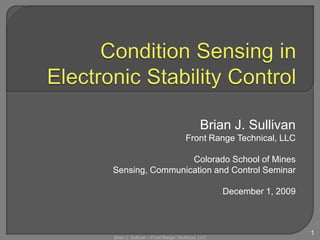
Condition Sensing In ESC
- 1. Condition Sensing in Electronic Stability Control Brian J. Sullivan Front Range Technical, LLC Colorado School of Mines Sensing, Communication and Control Seminar December 1, 2009
- 2. Goals of Electronic Stability Control (ESC) Sensor & Actuation Overview Methods of Control (focused on braking) Condition Sensing During Emergency Maneuvers General Applications to Controls Development Summary
- 3. Don’t Try This At Home… 2004 Dakar Rally – BMW X5 (via YouTube) Link to video: http://www.youtube.com/watch?v=MkfazA6d5Uc
- 4. Primary goal of ESC systems is to assist vehicle dynamics in order to match driver intent. Mitigate undesired vehicle behavior: Understeer Oversteer Tip-up / Rollover Goals of ESC
- 6. Front tires saturate, reducing ability to initiate yaw rate to follow intended path
- 7. Oversteer
- 8. Rear tires saturate, allowing yaw rate to exceed driver intent.Insurance Institute for Highway Safety
- 11. Steering Wheel Angle
- 14. Yaw Rate
- 15. Master Cylinder Pressure
- 16. Engine Management SensorsFrom Bosch Electronic Stability Program
- 18. Caliper Brake Pressures
- 20. Pitch RateFrom Bosch Electronic Stability Program
- 22. Longitudinal Wheel Slip
- 23. Front Axle Sideslip
- 24. Rear Axle Sideslip
- 25. Roll Angle
- 26. Pitch Angle
- 27. Caliper Fluid Pressure
- 28. Engine Torque
- 29. Axle Torque
- 30. many more…From Bosch Electronic Stability Program
- 32. Engine torque reduction or increase.
- 33. Steering angle input (in research phase)From Bosch Electronic Stability Program
- 34. Basic controller input from a ‘Bicycle Model’ Relates steering wheel angle, vehicle speed, yaw rate, and lateral acceleration, used to identify if vehicle is following intended path. Methods of Control - Understeer Fy Fy V af d ar
- 35. Stage 1 – Yaw Control Asymmetric ESC brake application induces a yaw moment on the vehicle Methods of Control - Understeer Background image from Acura
- 36. Stage 2 – Speed Control Vehicle speed is reduced through 4-wheel braking and/or engine torque reduction, which increases curvature for a given lateral grip. Methods of Control - Understeer Background image from Acura
- 37. Methods of Control - Oversteer Stage 1 – Yaw Control Initial braking induces a yaw moment on the vehicle Often omitted on rear axle to maintain lateral capacity Background image from Acura
- 38. Stage 2 – Lateral Force Control Further braking causes longitudinal wheel slip, collapsing lateral force on that wheel Utilized for both yaw control and roll control Methods of Control - Oversteer Background image from Acura
- 39. Condition sensing used in stability control: External/Environmental Surface condition detection (mu detection) State Estimation (yaw, roll, pitch angles) Maneuver-based Steering angle/rate sensitization Transition detection (Ay, yaw acceleration, sideslip) Driver braking or throttle Condition Sensing
- 40. Maneuvers are performed at various speeds and surfaces, and can be separated by driver steering inputs Single input: J-turn Reversed input: Fishhook, Single Lane Change 3-Input: Double Lane Change Repeated Input: Slalom Condition Sensing
- 41. Under some conditions, may need brake pressure to start building very quickly in order to generate slip on the control wheel. However, for maneuvers with single steering input, leading indicators are difficult to rely on. Mu detection requires tires reaching saturation Need multiple sensor readings within range of agreement to ensure signal plausibility Condition Sensing – Single Input
- 42. For these maneuvers, predominant actuation delay is related to initial pressurization of calipers, and seating brake pads against rotor. Precharge logic is utilized to apply low pressure to seat pads, reduce system compliance. Steering behavior Lateral acceleration/cornering May also be triggered by environmental factors: Radar-based (Collision Mitigation By Braking) Windshield wipers (primarily to dry rotors) Condition Sensing – Single Input
- 43. Condition Sensing – Double Input Reversed steering input adds requirement to manage roll and yaw momentum NHTSA Fishhook - National Highway Traffic Safety Administration
- 44. Condition Sensing – Double Input ESC Disabled Bosch Rollover Mitigation System Demonstration (via YouTube) Link to video: http://www.youtube.com/watch?v=yr0_UDCRk00
- 45. Condition Sensing – Double Input ESC Enabled Bosch Rollover Mitigation System Demonstration (via YouTube) Link to video: http://www.youtube.com/watch?v=Nss5EUAScag
- 46. ESC algorithms can be sensitized based on both the speed and magnitude of transitions across center Steering wheel angle/rate Yaw acceleration Lateral acceleration Vehicle sideslip (yaw axis) Vehicle roll angle (roll axis) Condition Sensing – Double Input
- 47. Actuation for reversed inputs can be improved by leveraging existing hydraulic potential Diagonal hydraulic split: use opposite hydraulic circuit to prefill calipers during first steering input, reducing lag on second control wheel upon transition. Front/Rear hydraulic split: use brake pressure on first control wheel as high-pressure accumulator to supply actuation on second control wheel upon transition. Condition Sensing – Double Input
- 48. Double lane changes are used to evaluate the ability to control yaw and roll momentum while maintaining path following. Numerous different layouts, speeds, driving styles, and surfaces (dry asphalt, gravel, snow, ice) Condition Sensing – Lane Change Consumer Union Short Lane Change
- 49. Repeated transitions, typically driven smoothly to evaluate system intrusiveness Run at a number of speeds & cone spacing to exercise different characteristic frequencies Used during calibration activities to tune controller holds, ramp rates, and sensitization. Condition Sensing - Slalom
- 50. Use leading indicators to ‘prime’ a physical system for larger actuation requests. Reduces actuation lag by managing slower dynamics. Allows time for signal plausibility to be verified. Limits effect of open-loop errors/uncertainties Use detection of rapid transitions across center to sensitize controllers Helps to leverage actuation potential to manage momentum, particularly for non-linear systems where traditional derivative control is not sufficient. General Applications
- 51. Validate sensitization strategies through repeated input transitions. Ensure sensitizations ramp out appropriately given natural frequencies of the system Can be used to verify duration of controller hold timers, ramp rates, and reset conditions. General Application
- 52. Questions?